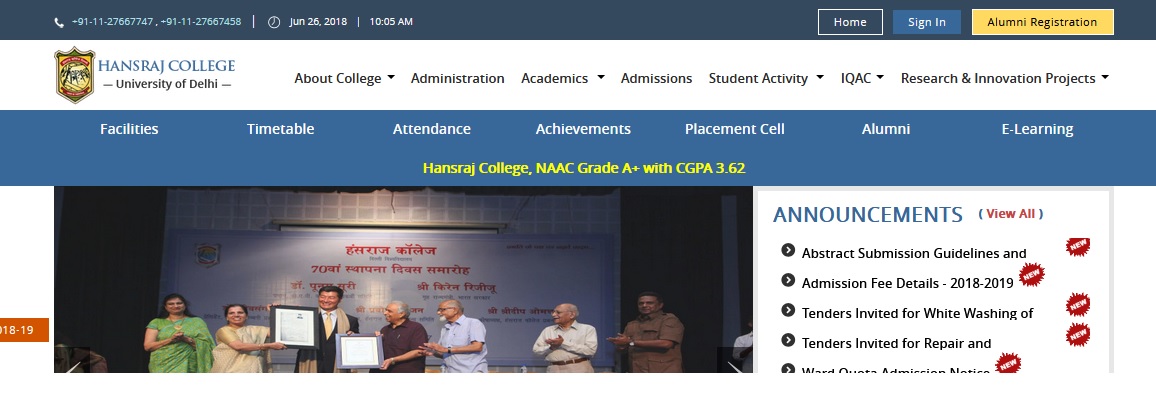Biodiversity Non-Chordata B.Sc Question Paper : hansrajcollege.co.in
Name of the University : University of Delhi
Name of the College : Hans Raj College
Department : Zoology
Degree : B.Sc
Name of the Subject : Biodiversity Non-Chordata
Document type : Model Question Paper
Website :hansrajcollege.co.in
Download Model/Sample Question Papers : https://www.pdfquestion.in/uploads/5400-ZOHT%20101.pdf
Hans Raj College Biodiversity Question Paper
Previous year question paper (Session 2011-2014) : ZOHT-101
DEPARTMENT OF ZOOLOGY
Paper II—ZOHT-101
Related : Guru Ghasidas Vishwavidyalaya Bilaspur B.Sc Zoology Sample Question Paper Sample : www.pdfquestion.in/7621.html
Biodiversity 1 : Biodiversity Non-Chordata
Time : 3 Hours Maximum Marks : 75
Attempt Five questions in all.
Question No. 1. is compulsory.
1. (a) Define any five of the following :
(i) Coelom
(ii) Protista
(iii) Epitoky
(iv) Tagmosys
(v) Nacre
(vi) Totipotent.
(vii) Evisceration
(viii) Metamerism 5
(b) Distinguish between any three of the of the following :
(i) Binary fission and budding
(ii) Polychaeta and Oligochaeta
(iii) Cilia and flagella
(iv) (Holometabolous and hemimetabolous
(iv) Bilateria and Radiata. 6
(c) Give the zoological names and classification of any three of the following animals
(i) Sea mouse
(ii) Water flea
(iii) Brittle star
(iv) Spider
(v) Jelly fish
(vi) Squid. 6
(d) Give the precise location of the following :
(i) Ospharidium
(ii) Mehlis’ gland
(iii) Radula
(iv) Spinnerets in spiders 4
(e) Match the terms in Column A with the appropriate one in Column B :
Column A Column B
(i) Ctenidium Nereis
(ii) Pedicellaria Mollusca
(iii) Pedipalps Echinoderata
(iv) Parpodia Spider 4

(f) Fill in the blanks
(i) The body cavity of Nematodes is called a. …………………………
(ii) Respiratory, structures in arachnids are called…………………….. 2
2. Give an account of sexual reproduction in protozoa. Discuss, its importance 12
3. What are corals? How do they form Coral Reefs? Give an account of the various types of Coral Reefs found in the world. 12
4. Describe the life history of Ascaris. How does it differ from that of I Liver Fluke? Discuss its parasitic adaptations. 12
5. Draw a labelled diagram of the body wall of sycon. Describe its canal system and add a note on its functions. 12
6. Define Eusociality. What are the requisites of a social community? Compare the social organization of termites with that of bees. 12
7. Give the general characters of the Phylum Cnidaria and describe the different polymorphic forms in them and give their functions. 12
8. Give an account of the structure and function of the water vascular system in Echinoderms. 12
9. (a) Give the distinguishing features of the major classes of Phylum Molluscs.
(b) Explain the phenomenon of Torsion in gastropods. 6,6
10. Write short notes on any three of the following 4,4,4
(i) Compound eye;
(ii) Metamerism;
(iii) Foot in cephalopoda
(v) Origin of Metazoa;
(v) Adaptive radiation in polychaeta;
(vi) Locomotion in Sarcodina.
Name of the Paper : Biodiversity I:
Year : 2017
Name of the Course : B.Sc. Honors Zoology
Duration : 3 Hours
Maximum Marks : 75
(Write your Roll No. on the top immediately on receipt of this question paper.)
Attempt five questions in all.
Question No. 1 is compulsory.
1. (a) Define the following : 1 x6
(i) Laurer’s canal
(ii) Scleroblast
(iii) Holotrophic nutrition
(iv) Radial symmetry
(v) Prosopyle
(vi) Flame cells.
(b) Give location and function/significance of the following : 2×4
(i) Pinacocytes
(ii) Trophozoite stage of Plasmodium vivax
(iii) Stigma in Euglena
(iv) Hexacanth larvae.
(c) Distinguish between :
(i) Spongocoel and Coelenteron
(ii) Miracidium and Metacercaria larvae
(iii) Protostomes and Deuterostomes
(iv) Schyphozoa and Anthozoa.
(d) Give the systematic classification of the following (upto class) :
(i) Euglena
(ii) Glass rope sponge
(iii) Jellyfish
(iv) Liver fluke
(v) Mushroom coral.
Draw a well labeled diagram and explain the life cycle of Plasmodium vivax.
(a) Briefly explain the life cycle of Taenia solium.
(b) Explain the various theories of locomotion in Sarcodina.
(a) Give an account of polymorphism in Cnidaria, using suitable diagrams.
(b) Briefly discuss the affinities of Ctenophora.
Describe the life cycle of Wuchereria bancrofti. Add a note on its pathogenicity.
(a) Define metamerism. Explain the evolution of metamerism in metazoa.
(b) Briefly discuss about spicules in sponges.
Write short notes on any three of the following :
(i) Leuconoid canal system
(ii) Autogamy
(iii) Coral reefs
(iv) Metagenesis
(v) Ascariasis.